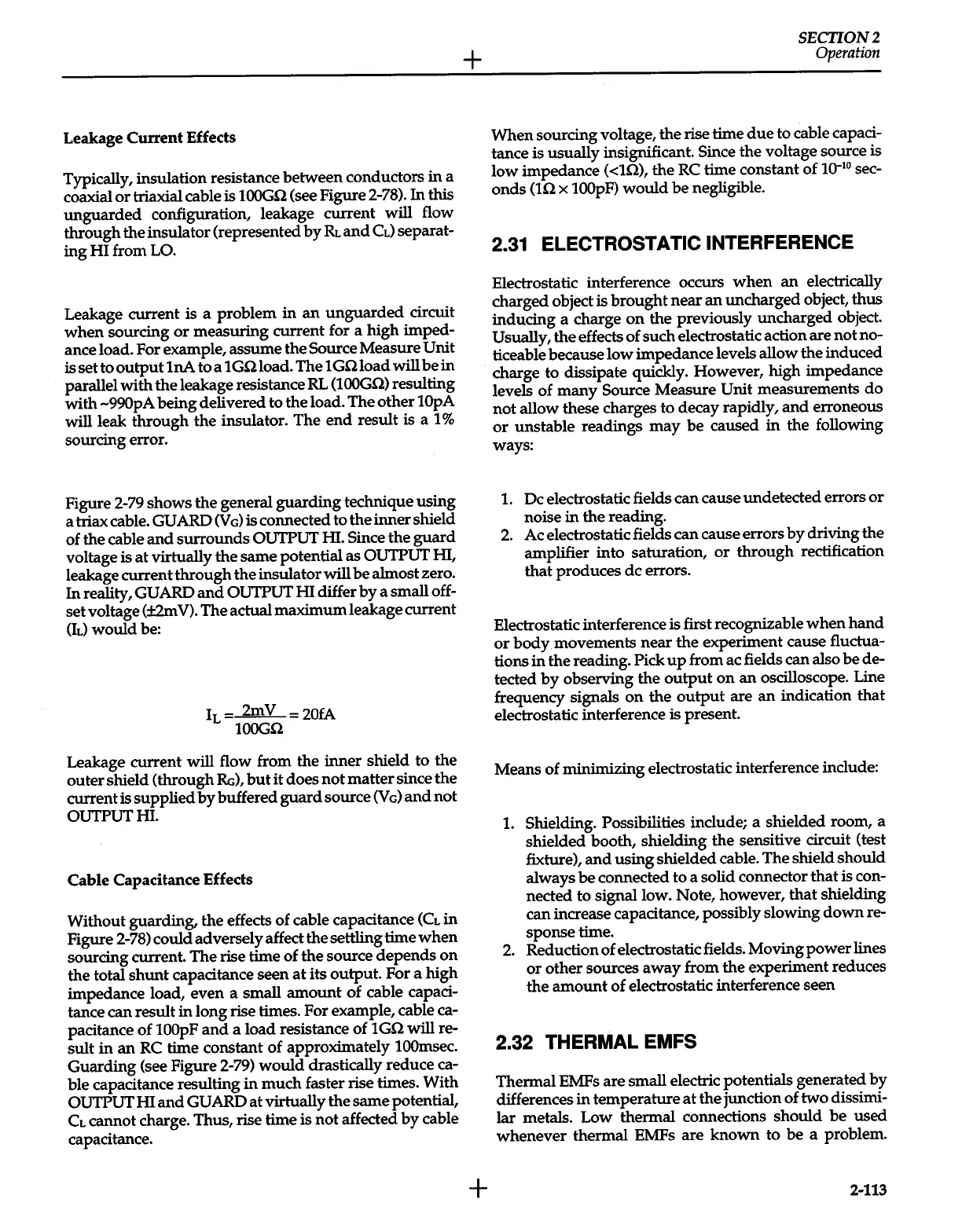Leakage
Current
Effects
Typically, insulation resistance between conductors
in
a
coaxial
or
triaxial cable is
lOOGQ
(see Figure 2-78). In
this
unguarded
configuration, leakage current will flow
through the insulator (represented
by
&
and
CL)
separat-
ing
HI
from
LO.
Leakage current is a problem
in
an
unguarded
circuit
when
sourcing
or
measuring current for a high imped-
ance load. For example, assume the Source
Measure
Unit
is
setto
output
lnA
to a
lGQ
load. The
lGQ
load
will
be
in
parallel
with
the leakage resistance
RL
(lOOGQ)
resulting
with
-990pA
being delivered to the load. The other
lOpA
will
leak through the insulator. The
end
result is a
1%
sourcing error.
Figure 2-79 shows the general
guarding
technique using
a triax cable.
GUARD
(V
G)
is connected to
the
inner shield
of the cable
and
surrounds
OUTPUT
HI.
Since
the
guard
voltage is
at
virtually the same potential as OUTPUT
HI,
leakage current through the insulator
will
be
almost zero.
In reality,
GUARD
and
OUTPUT
HI
differ
by
a small off-
set voltage
(±2m
V).
The actual maximum leakage current
(IL)
would
be:
h
2mV 20fA
lOOGQ
Leakage current will flow from the inner shield to the
outer shield (through
Rc),
but
it
does
not
matter since
the
current is supplied
by
buffered
guard
source
(V
G)
and
not
OUTPUT
HI.
Cable Capacitance Effects
Without guarding, the effects of cable capacitance
(CL
in
Figure 2-78) could adversely affect the settling time
when
sourcing current. The rise time of the source
depends
on
the total
shunt
capacitance seen
at
its output. For a high
impedance load, even a small
amount
of
cable capaci-
tance can result
in
long rise times. For example, cable ca-
pacitance of
lOOpF
and
a load resistance of
lGQ
will
re-
sult
in
an
RC
time constant
of
approximately
lOOmsec.
Guarding (see Figure 2-79)
would
drastically reduce ca-
ble capacitance resulting
in
much
faster rise times. With
OUTPUT
HI
and
GUARD
at
virtually the same potential,
CL
cannot charge. Thus, rise time is
not
affected
by
cable
capacitance.
+
+
SECTION2
Operation
When sourcing voltage, the rise time
due
to cable capaci-
tance is usually insignificant.
Since
the voltage source is
low
impedance
(<10),
the
RC
time constant of
to-
10
sec-
onds
(ln
x
lOOpF)
would
be
negligible.
2.31
ELECTROSTATIC
INTERFERENCE
Electrostatic interference occurs
when
an
electrically
charged object is
brought
near
an
uncharged object, thus
inducing a charge
on
the previously uncharged object.
Usually,
the effects of such electrostatic action are
not
no-
ticeable because
low
impedance levels allow the induced
charge to dissipate quickly. However, high impedance
levels of
many
Source Measure
Unit
measurements
do
not
allow these charges to decay rapidly,
and
erroneous
or
unstable readings
may
be
caused
in
the following
ways:
1.
De electrostatic fields can cause undetected errors
or
noise
in
the reading.
2.
Ac electrostatic fields can cause errors
by
driving the
amplifier into saturation,
or
through
rectification
that produces
de
errors.
Electrostatic interference is first recognizable
when
hand
or
body
movements near the experiment cause fluctua-
tions
in
the reading. Pick
up
from ac fields can also
be
de-
tected
by
observing the
output
on
an
oscilloscope. Line
frequency signals
on
the
output
are
an
indication that
electrostatic interference is present.
Means of minimizing electrostatic interference include:
1.
Shielding. Possibilities include; a shielded room, a
shielded booth, shielding the sensitive circuit (test
fixture),
and
using shielded cable. The shield should
always
be
connected to a solid connector
that
is con-
nected to signal low. Note, however,
that
shielding
can increase capacitance, possibly slowing
down
re-
sponse time.
2.
Reduction of electrostatic fields. Moving
power
lines
or
other sources
away
from the experiment reduces
the
amount
of electrostatic interference seen
2.32 THERMAL
EMFS
Thermal EMFs are small electric potentials generated
by
differences
in
temperature
at
the junction of
two
dissimi-
lar metals. Low thermal connections should
be
used
whenever thermal EMFs are
known
to
be
a problem.
2-113
